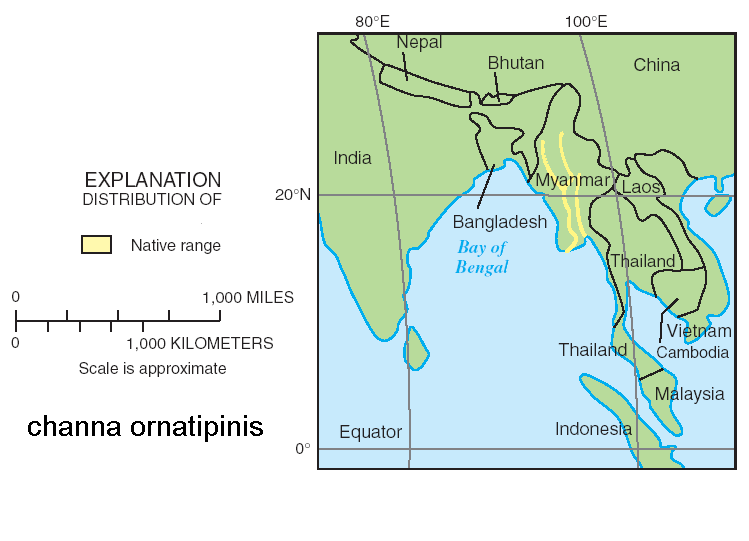updated 11th december 08 to update information
Species name: Channa pulchra
Common name: burmese snakehead
Maximum size: around 20-25cm
Origin: Southern: Irrawaddy and Sitang River basins Myanmar
please note map shows ornatipinis but pulchra is found in the same area
 introductions:
introductions: none as yet!!
Temperament: fairly aggresive , will not tolerate members of itsown kind in small spaces , although a dwarf species req,s a largewell structured tank to house a group
Company: best kept in a species tank , do not mix with tropicalsas these are sub-tropical fish and will not fair well , giventhe correct aquarium setting these can be a nice 1st snakehead , theybecome more aggresive the less the space provided for them is.
Water parameters: Temperature 18-25 c ; pH avoid extreams,slighly softer water , although these guys can stand higher levels oftemp for periods of time they sould not be kept year round at theesetemps. there behavior is directly affected by tempreture , and veryhigh temps are thought to be stressfull
Identification: similar to ornatipinis but have much smallerless prominent black spots on head , useally shows 1 2 or 3 black spotsin dorsal fin
tank set-up: an important consideration for theese guys , eventhough they are considered as a dwarf species , please aquascape as ifthey where at least a medium sized snakehead , they can be aggresiveamoung each other and need there own terratories , where they are found theriver bed is made up of volcanic rock (red lava) use of theese andplants can make a realistic biotope setting. temp should besub-tropical with a lower safe guard set at around 16deg ambient tempsshould take care of the higher temps , high temps in there natural range peak just into the lower tropical range
as with ornatipinis they inhabit a stream that is fed from the hiymalayamountains , in the wet season it is very wet with snow melt from themountain causing fast flowing waters high oxogen content and higher phvalues, in the drt season the opostite happens , streams dry up snowstops melting , so the stream turns into a series of isolated pools ,in theese pools the oxogen content slowly drops as does ph and waterlevel , in the aquarium this can be replicated by installing a sio,tunze ect powerhead at the surface during winter months , when summercomes round we can drop the level of the water ,turn off the pumps atthe surface and add hardwood leaves to soften the water , by mimicingnature in this way we stand the best chance of getting these wonderfullfish to breed in aquaria , and also ensure they are at there happiest
other notes: now fairly easy to obtain and many people havehad sucsess breeding in the aquarium, this has pushed prices down andthis fish is now available from around £6-8 for a juvinile and around£15-20 for an adult. compared to around £50 each just a year ago. thisis great news for the species and great news for the trade. with asnakehead ban accross the whole of europe still on the agenda this typeof breeding sucsess will ensure pulchra is here to stay
breeding: start out with small group , grow them up together ,at some point aggresion levels will rise dramaticly and you shouldnotice two of the fish pairing off together , swiming round each otherect. when you see this and you are certain that you know which to arethe pair ,move other fish out of tank. spawning should follow fairlysoon afterwards, eggs are put into a float ,any stray eggs arecollected by parents in the mouth and expelled through the gills in thesame location as the main float. eggs are gaurded by parents , and somefeeder eggs have been whitnessed but once fry are free swimming theyare happy to take new born brineshrimp.

















